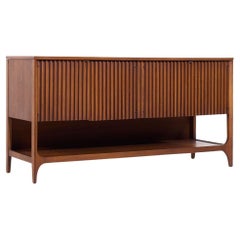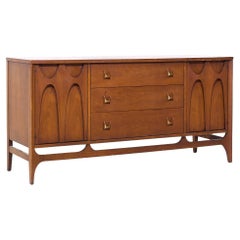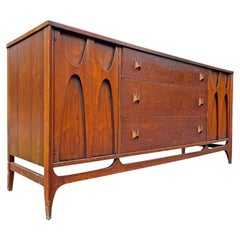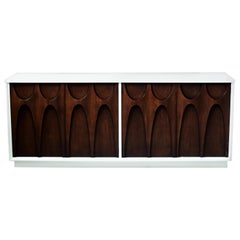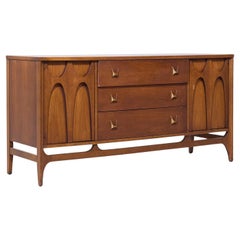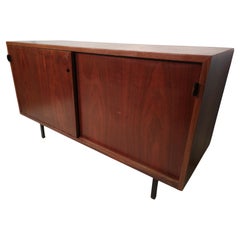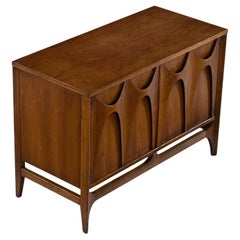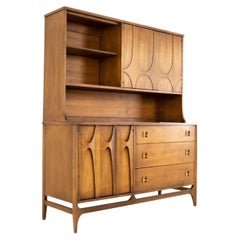Broyhill Brasilia Credenzas
No other American mid-century furniture line has become as synonymous with a certain type of curvilinear decoration as Broyhill’s Brasilia group. While its revered cabinets, credenzas, dressers, dining chairs and more were made in the United States, the inspiration for the distinguishing characteristics of vintage Broyhill Brasilia furniture can actually be found in Latin American architecture.
Broyhill Furniture Industries was launched in Lenoir, North Carolina by brothers Thomas H. and James Edgar “Ed” Broyhill. Ed had been working for his brother’s furniture manufacturing company, the Lenoir Furniture Corporation, which produced bedroom furnishings in the 1920s, when a nearby supplier’s factory, Bernhardt Chair Company, burned in a fire. Ed founded Lenoir Chair Company and expanded its operations while remaining an employee at Lenoir Furniture Corporation. He subsequently partnered with Thomas and together they purchased Harper Furniture Company, a local producer of Colonial Revival-style furniture, in 1929.
By the 1940s, Broyhill Furniture Industries had absorbed more factories and gained footing as a strong competitor of Lenoir’s Kent-Coffey Manufacturing Company and a rebuilt Bernhardt Furniture.
In the mid-1950s, responding to changing tastes and to an appetite for what is now universally known as mid-century modern furnishings, the firm launched its Broyhill Premier line with the Sculptra series. Sculptra pieces featured a square-within-a-square motif and horizontal cat’s-eye-shaped drawer pulls. Later, in 1962, the Broyhill Brasilia furniture group debuted at the Seattle World’s Fair. The collection was heavily inspired by Oscar Niemeyer’s modernist buildings for the eponymous Brazilian capital.
Designed and built by Niemeyer between 1956 and 1960, the modernist architecture of Brasília’s state capitol buildings has since taken on iconic status. The elegant curves of Niemeyer's works — those that characterize the white concrete structures that encase Palácio do Planalto in addition to the fluid inverted arches of the Supreme Federal Court Building — can be seen in the pronounced decorative elements that adorn the Broyhill Brasilia group’s sleek walnut highboy dressers, specifically in their striking brass drawer-pull arches and carved moldings. While considerably popular during the 1960s, the production of the Brasilia line — with its beloved two-tiered bedside tables and tasteful sideboards — was discontinued in 1970.
On 1stDibs, browse vintage mid-century Broyhill Brasilia furniture, such as its walnut dressers, dining chairs, case pieces and more.
1970s American Mid-Century Modern Vintage Broyhill Brasilia Credenzas
Walnut
1970s American Mid-Century Modern Vintage Broyhill Brasilia Credenzas
Brass
1960s American Modern Vintage Broyhill Brasilia Credenzas
Wood
1960s American Mid-Century Modern Vintage Broyhill Brasilia Credenzas
Wood
Mid-20th Century American Mid-Century Modern Broyhill Brasilia Credenzas
Brass
1950s American Mid-Century Modern Vintage Broyhill Brasilia Credenzas
Steel
2010s Turkish Modern Broyhill Brasilia Credenzas
Walnut, Wood
Mid-20th Century Dutch Mid-Century Modern Broyhill Brasilia Credenzas
Brass
1950s American Mid-Century Modern Vintage Broyhill Brasilia Credenzas
Chrome
1970s American Mid-Century Modern Vintage Broyhill Brasilia Credenzas
Walnut
2010s American Modern Broyhill Brasilia Credenzas
Brass
1960s American Mid-Century Modern Vintage Broyhill Brasilia Credenzas
Brass
1960s American Mid-Century Modern Vintage Broyhill Brasilia Credenzas
Walnut
1960s Mid-Century Modern Vintage Broyhill Brasilia Credenzas
Walnut
1960s American Mid-Century Modern Vintage Broyhill Brasilia Credenzas
Brass
Mid-20th Century American Mid-Century Modern Broyhill Brasilia Credenzas
Brass
1960s Mid-Century Modern Vintage Broyhill Brasilia Credenzas
Walnut
1960s American Mid-Century Modern Vintage Broyhill Brasilia Credenzas
Walnut
Mid-20th Century American Mid-Century Modern Broyhill Brasilia Credenzas
Brass
1970s American Mid-Century Modern Vintage Broyhill Brasilia Credenzas
Brass
1960s American Mid-Century Modern Vintage Broyhill Brasilia Credenzas
Brass
1960s American Mid-Century Modern Vintage Broyhill Brasilia Credenzas
Brass
1960s American Mid-Century Modern Vintage Broyhill Brasilia Credenzas
Brass
1970s American Mid-Century Modern Vintage Broyhill Brasilia Credenzas
Walnut
1970s American Mid-Century Modern Vintage Broyhill Brasilia Credenzas
Brass
1970s American Mid-Century Modern Vintage Broyhill Brasilia Credenzas
Brass
1960s American Mid-Century Modern Vintage Broyhill Brasilia Credenzas
Brass
1960s American Mid-Century Modern Vintage Broyhill Brasilia Credenzas
Walnut
20th Century American Mid-Century Modern Broyhill Brasilia Credenzas
Walnut
Find Vintage Broyhill Brasilia Credenzas and Other Credenzas on 1stDibs
Antique and vintage credenzas can add an understated touch of grace to your home. These long and sophisticated cabinet-style pieces of furniture can serve a variety of purposes, and they look great too.
In Italy, the credenza was originally a small side table used in religious services. Appropriately, credere in Italian means “to believe.” Credenzas were a place to not only set the food ready for meals, they were also a place to test and taste prepared food for poison before a dish was served to a member of the ruling class. Later, credenza was used to describe a type of versatile narrow side table, typically used for serving food in the home. In form, a credenza has much in common with a sideboard — in fact, the terms credenza and sideboard are used almost interchangeably today.
Credenzas usually have short legs or no legs at all, and can feature drawers and cabinets. And all kinds of iterations of the credenza have seen the light of day over the years, from ornately carved walnut credenzas originating in 16th-century Tuscany to the wealth of Art Deco credenzas — with their polished surfaces and geometric patterns — to the array of innovative modernist interpretations that American furniture maker Milo Baughman created for Directional and Thayer Coggin.
The credenza’s blend of style and functionality led to its widespread use in the 20th century. Mid-century modern credenzas are particularly popular — take a look at Danish furniture designer Arne Vodder’s classic Model 29, for instance, with its reversible sliding doors and elegant drawer pulls. Hans Wegner, another Danish modernist, produced strikingly minimalist credenzas in the 1950s and ’60s, as did influential designer Florence Knoll. Designers continue to explore new and exciting ways to update this long-loved furnishing.
Owing to its versatility and familiar low-profile form, the credenza remains popular in contemporary homes. Unlike many larger case pieces, credenzas can be placed under windows and in irregularly shaped rooms, such as foyers and entryways. This renders it a useful storage solution. In living rooms, for example, a credenza can be a sleek media console topped with plants and the rare art monographs you’ve been planning to show off. In homes with open floor plans, a credenza can help define multiple living spaces, making it ideal for loft apartments.
Browse a variety of antique, new and vintage credenzas on 1stDibs to find the perfect fit for your home today.
Creators Similar to Broyhill Brasilia
- What year was Broyhill Brasilia?1 Answer1stDibs ExpertMarch 3, 2023The first year for the Broyhill Brasilia line was 1962. North Carolina’s Broyhill Furniture Industries introduced its Brasilia series at the Seattle World’s Fair. Pieces in the collection reflect mid-century modern style conventions with their clean lines, organic shapes and overall simplicity. Shop an assortment of vintage Broyhill Brasilia furniture on 1stDibs.
